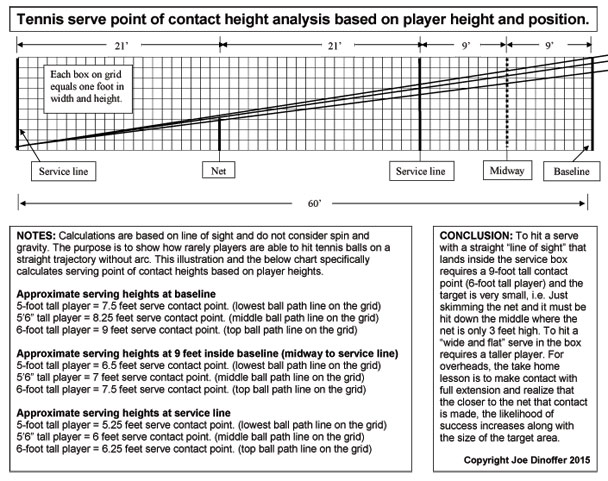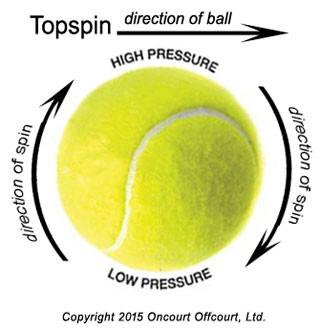|
TennisOne Lessons Understand "Line of Sight" for Better Tennis A Key to Minimize Unforced Errors and Win More Matches Joe Dinoffer If you watched the blockbuster movie “Independence Day” then you should remember how the alien communications network was set up based on “line of sight” signals. It’s the same with satellite television signals, which is why our local Dallas satellite dish network would not work at my house. It seems there are too many trees and the satellite dish had to aim at a point above Brazil where that company’s satellite hovers in orbit. It’s also the same with speeding tickets. If the officer aiming his radar gun cannot point it generally in your direction (or if another car blocks the line of sight), then your speed cannot be measured. For tennis, line of sight implications are numerous and it is certainly one of the important things to understand if you want to minimize your unforced errors on a tennis court. Let’s continue this article by sharing three crucial “facts” to keep in mind. Then we will analyze the impact of line of sight reasoning for the serve, groundstrokes, and volleys. From these three groupings, you should be able to expand this concept into specialty shots like dropshots, lobs, and overheads, as well as how to play better defensive tennis. Fact #1: The Net Creates an Illusion
Have you ever covered the net with a sheet or blanket? If you haven’t, give it a try. First stand on the baseline and try to see over the net to any part of the playing area inside the court on the other side. You won’t be able to. Then, slowly walk up to the net and stop when you see the opponent’s baseline (still looking over the net). Chances are you will be standing close to your own service line. This means that if you contact the ball at eye level and stand in that spot, you only have a 2-inch deep white line to aim for if you hit flat and straight to your target! Obviously, that’s a ridiculously small target to aim for. Next, walk further forwards until you see the opposite service line above the net. Now, if you again contact the ball at eye level and stand in that spot, you now have an 18-foot deep target if you hit flat from eye level. Now squat down to lower your line of sight to chest and then waist level. This simulates making contact at a lower height, which is more common. At this contact height, you will not be able to hit hard, flat, and on a straight line and keep it in the court. Yes, the net is an illusion. Although you can see through it, you cannot hit through it! Fact #2: Hitting On a Straight Line is Rare From Fact #1 we learn that only when you are contacting the ball around the service line and above shoulder height can you really hit hard and flat and have a reasonable-sized target area. Therefore since most shots in tennis are hit from further back in the court and at a lower height, we conclude that hitting on a straight line and keeping the ball in play is just not that common. Now take a thorough look at the illustration on this page. This drawing analyzes your height and point of contact when serving and hitting overheads from different spots on the court. It also shows how much easier it is to clear the net with hard and flat serves over the low part of the net, as compared to hitting wide where the net can be several inches or 10% higher.
Fact #3: Gravity, Drag, and Spin are Your Friends After reading Fact #1 and Fact #2 this next point should make you feel a lot better about tennis. Fact #3 is that gravity, drag, and spin are your friends. What does this mean? First, we need to accept that well over 90% of all our shots on a tennis court are hit with arc. Tennis, unlike baseball, rewards us for two things: Hitting the ball over the net AND inside the lines. Baseball, on the other hand, rewards us heroically for hitting home runs … and the further the better! Once you arc the ball in tennis (to get it over the net), there are three primary forces that bring the ball inside the lines. The first is gravity and this needs no explanation.
The third friend is spin. Let’s specifically talk about topspin in this article. When a ball is hit with forwards or topspin, it creates a small high pressure air system above the ball and a small area of low pressure air underneath it. The high pressure above acts alongside gravity to literally push the ball downwards towards the court. This is why topspin, in particular, is the “go-to” spin to hit with high net clearance and also high safety margins to keep the ball inside the court. It also has the benefit of bouncing up relatively high to your opponent, which often forces them to contact the ball out of their comfort zone. In the illustration on the left, the ball is hit with topspin and is moving from left to right. Serve The serve in tennis is the most commonly hit stroke. No question about it. Without a good serve, players are severely restricted in their improvement and competitive results. Remember Rafael Nadal’s serve when he first arrived on the world stage? His first and second serve were consistent, well placed, and had sufficient arc that he hardly ever hit a serve into the net. Gradually he added a less spinny faster first serve to his repertoire. The lesson to learn here is that he became the number one player in the world without a powerful serve! His coach clearly understood that consistency and control were more important than power and that he was not tall enough to hit hard and flat without considerably shrinking his margin for error. It doesn’t matter how hard you hit your first serve if you cannot get a high percentage of them in the box! Groundstrokes In Fact #1 we discussed line of sight on groundstrokes from different spots on the court. What we did not discuss was where and when you can hit a straight flat groundstroke. It’s pretty simple and you probably already figured it out. Just keep in mind that you cannot make a blanket rule like, “Players can hit hard, flat, and straight when inside the service line and can contact the ball at shoulder height or above.” Why? Because it depends on the height of the player. That said, as a general rule, you can say that the closer you are to the net and the higher you contact the ball, the flatter and harder you can hit it. Just remember that when you cannot hit flat and straight, you have to hit with arc and spin. How often is that? Only about 95% of the time! Volleys The same principles apply to volleys. Of course, most volleys are hit from inside the service line, but your opponent is usually aware of your position and they are trying to hit the ball to your feet. You, on the other hand, are trying to move as close to the net as possible so you can contact the ball above the net and therefore hit harder to finish the point. What’s the best volley position to play from? As close to the net as possible! Just keep in mind that if you don’t have a signed agreement from your opponent that promises they will not lob, you have to compromise that position and hang back to about midway between the service line and the net.
Closing Let’s finish with a drill called “Above-Below” which refers to contacting the ball either at chest height and above or below it. Of course, we know from earlier in this article that just because you contact the ball at chest height does not automatically mean you will be able to have direct “line of sight” into your opponents court. However, when you are able to contact the ball at chest height or above, odds are that you can hit more aggressively as compared to hitting from a lower point of contact. While the concept and rules are very simple, this exercise can speed your improvement significantly plus it applies to both groundstrokes and volleys for all levels of play. Here are the rules: You can play bounce-hit points with two players starting on the baseline or serve and play a normal set. The only rule adjustment is that each player must call out either “above” or “below” before the ball bounces on their side of the net on groundstrokes or before the ball crosses the net on volleys. And, whatever that player calls out is what he or she must do. For examle, if a player calls out “above” but contacts the ball below chest height instead of higher, the point is immediately lost. The other way to immediatley lose a point is to forget to call it out entirely. Here’s a final word of advice to make sure this drill works as intended. Whispering does not count. The player on the other side of the net must hear what you announce. This rule not only keeps everyone honest, but it also forces players to be quick and decisive, both positive qualities in a tennis player! Your comments are welcome. Let us know what you think about Joe Dinoffer's article by emailing us here at TennisOne.
Joe Dinoffer is among 10 master professionals in both the USPTA and PTR. He was also awarded the USPTA National Industry Excellence Award as well as Texas Division Pro of the Year. He has written and produced 7 books and 22 DVDs and has appeared numerous times on the Tennis Channel. Joe is also the founder and President of Oncourt Offcourt, Ltd., a tennis company recognized as one of the most creative in the industry. See his work at www.OncourtOffcourt.com.
|

 The second is drag or friction with the air, which can slow the ball down even more than gravity. And, the more humid the air, the more drag (air friction) slows the ball down. This is why big hitters lose some of their advantage when playing in humid conditions and they gain advantage at higher elevations with dry air conditions when their balls travel proportionately faster.
The second is drag or friction with the air, which can slow the ball down even more than gravity. And, the more humid the air, the more drag (air friction) slows the ball down. This is why big hitters lose some of their advantage when playing in humid conditions and they gain advantage at higher elevations with dry air conditions when their balls travel proportionately faster.  Joe Dinoffer
Joe Dinoffer